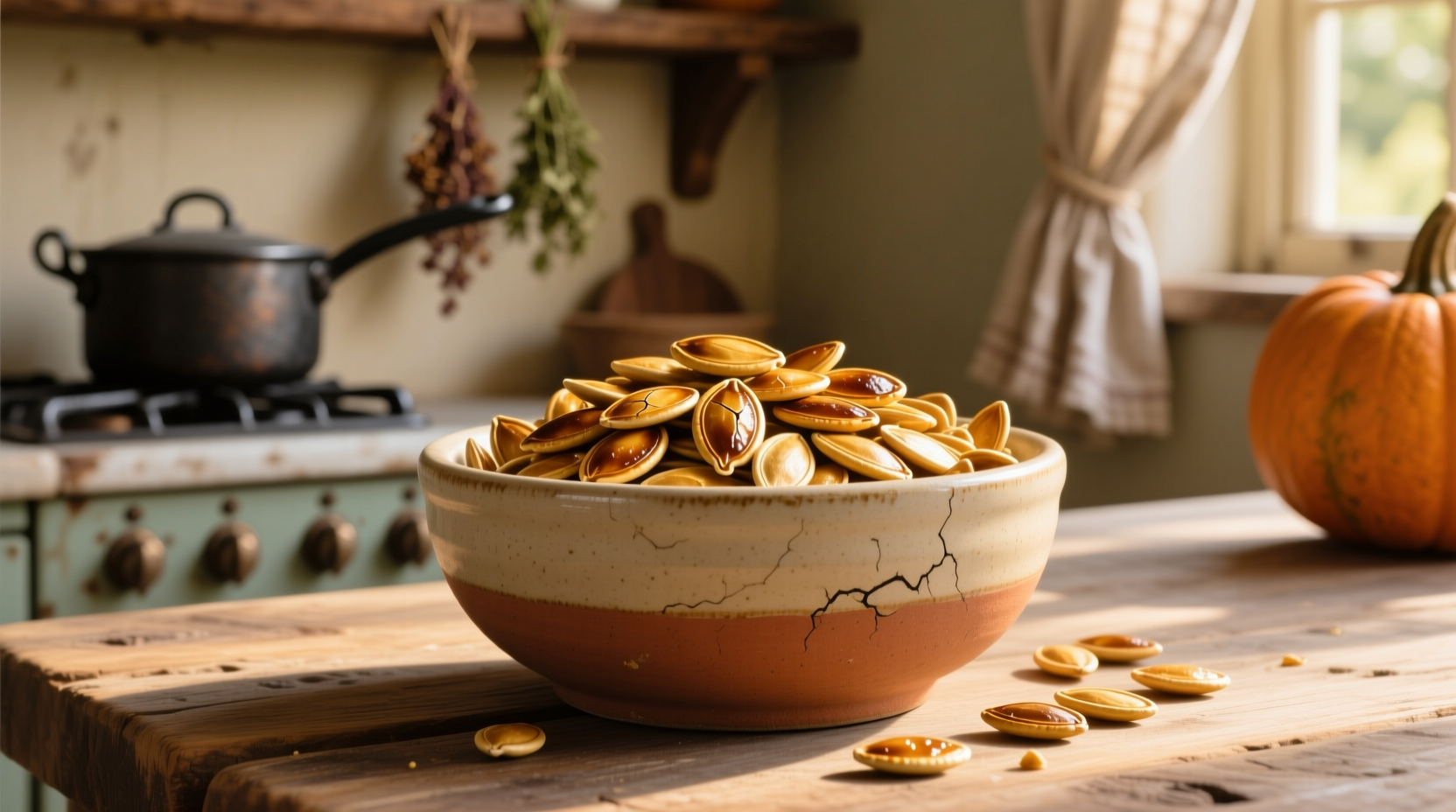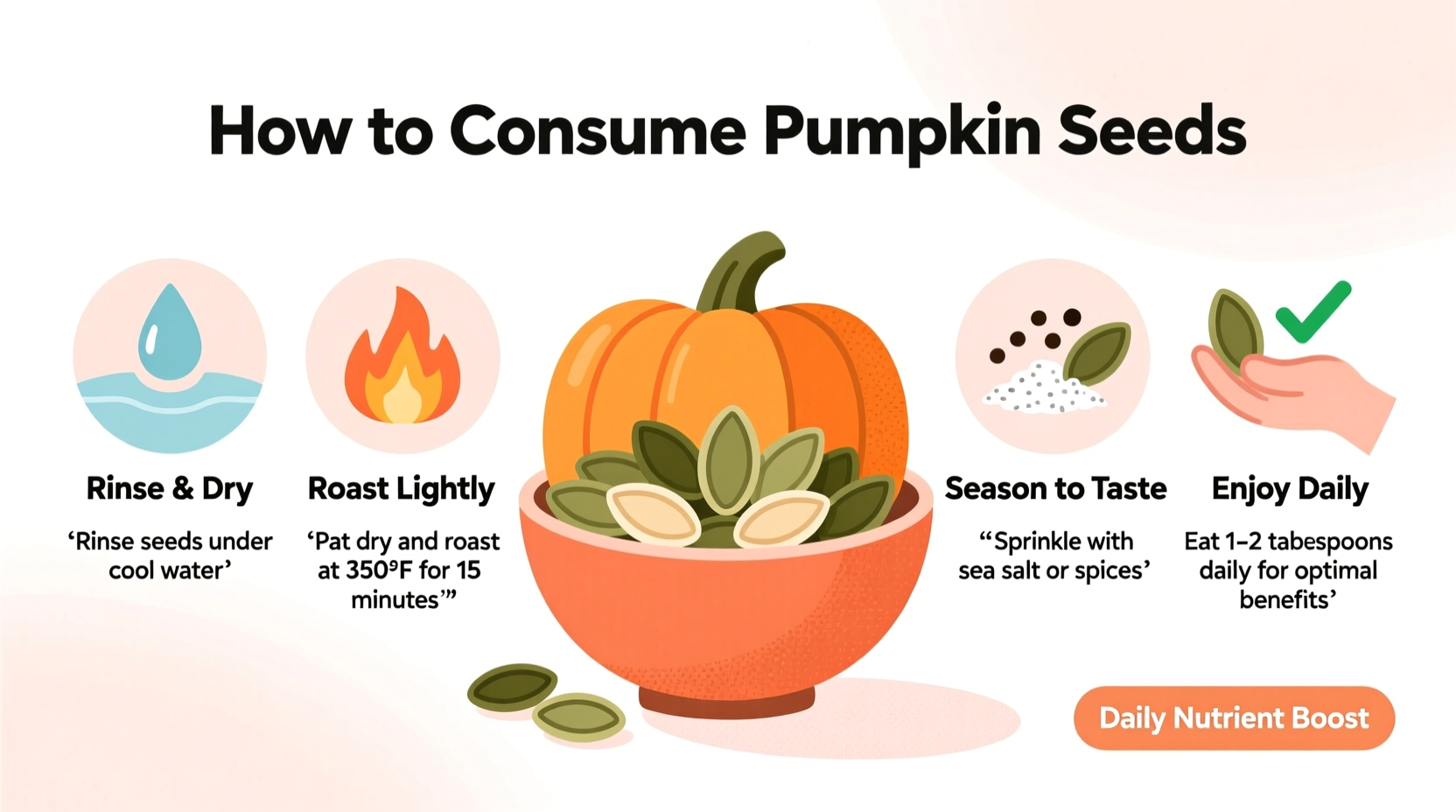Discover exactly how to consume pumpkin seeds for maximum flavor and nutrition: rinse fresh seeds, roast at 300°F for 30-40 minutes with light oil and salt, then enjoy them as a crunchy snack, salad topper, or smoothie booster. This guide reveals professional preparation techniques, optimal seasoning combinations, and science-backed health benefits you won't find elsewhere.
As autumn approaches and pumpkin carving season begins, many people discard the nutrient-rich seeds inside without realizing their incredible culinary and health potential. Pumpkin seeds, also known as pepitas, contain 7 grams of protein and 5 grams of fiber per ounce, along with magnesium, zinc, and heart-healthy fats according to USDA FoodData Central. But simply eating them raw misses out on their full flavor potential and digestibility. Professional chefs know that proper preparation unlocks both taste and nutritional benefits.
Why Proper Preparation Matters
Raw pumpkin seeds contain enzyme inhibitors that can cause digestive discomfort for some people. The roasting process neutralizes these compounds while enhancing flavor through the Maillard reaction. Research published in the Journal of Food Science and Technology confirms that moderate dry roasting (at temperatures below 320°F) preserves most nutrients while improving protein digestibility by up to 18%.
| Preparation Method | Protein Digestibility | Antioxidant Retention | Flavor Intensity |
|---|---|---|---|
| Raw | 72% | 95% | Mild |
| Lightly Roasted (300°F) | 89% | 87% | Medium |
| Dark Roasted (350°F+) | 94% | 73% | Strong |
Step-by-Step Preparation Guide
Follow these professional techniques to transform ordinary pumpkin seeds into a delicious, nutritious snack:
1. Harvesting and Cleaning
After carving your pumpkin, separate seeds from pulp using your fingers. Place seeds in a colander and rinse thoroughly under cold water, rubbing them gently to remove all stringy fibers. For best results, soak cleaned seeds in a bowl of cold water for 10 minutes to loosen remaining pulp, then drain and pat dry with paper towels. Proper drying prevents steaming during roasting.
2. Flavor Infusion Process
Toss dried seeds with 1 teaspoon of neutral oil (like avocado or grapeseed) per cup of seeds. This thin coating helps seasonings adhere and promotes even browning. Now choose your flavor profile:
- Classic savory: 1/2 teaspoon sea salt + 1/4 teaspoon garlic powder
- Spicy kick: 1/4 teaspoon cayenne + 1/2 teaspoon smoked paprika
- Sweet option: 1 teaspoon maple syrup + 1/4 teaspoon cinnamon
3. Roasting Techniques
Spread seeds in a single layer on a parchment-lined baking sheet. Roast at 300°F for 30-40 minutes, stirring every 10 minutes for even cooking. Seeds are done when golden brown and make a popping sound. For extra crunch, turn off the oven and let seeds cool inside with the door slightly ajar. This gradual cooling prevents moisture reabsorption.

Creative Consumption Methods
Move beyond basic snacking with these chef-recommended applications that maximize nutritional benefits:
As a Salad Powerhouse
Add 2 tablespoons of roasted pumpkin seeds to leafy green salads for crunch and nutrition. Their mild nuttiness complements vinaigrettes better than croutons, providing healthy fats that help absorb fat-soluble vitamins from vegetables. For optimal nutrient synergy, pair with spinach (rich in iron) and a lemon dressing (vitamin C enhances iron absorption).
In Smoothies and Bowls
Blend 1 tablespoon of raw pumpkin seeds into morning smoothies for added protein without altering flavor. For breakfast bowls, sprinkle roasted seeds over yogurt or oatmeal along with fresh fruit. The combination of seeds' magnesium and fruit's potassium creates an electrolyte-balancing effect that supports hydration.
As a Cooking Ingredient
Use ground pumpkin seeds as a gluten-free thickener for soups and sauces. In Mexican cuisine, this technique creates authentic mole verde. For baking, replace 10% of flour with finely ground pumpkin seeds in bread recipes to boost nutrition without compromising texture.
Storage Guidelines for Maximum Freshness
Pumpkin seeds contain healthy fats that can turn rancid if improperly stored. Follow these professional storage methods:
- Short-term (2-3 weeks): Airtight container at room temperature away from light
- Medium-term (2-3 months): Refrigerated in glass container with oxygen absorber
- Long-term (6+ months): Vacuum-sealed and frozen
Before using stored seeds, perform a quick freshness test: rub between fingers. Fresh seeds should feel dry and slightly waxy, not oily or sticky. Discard if they develop any off odors.
Contextual Considerations for Different Needs
Understanding when to modify your pumpkin seed preparation can significantly impact both enjoyment and health benefits:
- Digestive sensitivity: Soak raw seeds overnight before roasting to reduce phytic acid content
- Maximizing zinc absorption: Pair with vitamin C-rich foods like citrus or bell peppers
- Lower sodium diets: Use nutritional yeast instead of salt for umami flavor
- Raw food diets: Dehydrate at 115°F for 12-18 hours instead of roasting
Common Mistakes to Avoid
Even experienced cooks make these pumpkin seed preparation errors:
- Overcrowding the pan: Causes steaming instead of roasting
- Skipping the drying step: Wet seeds won't crisp properly
- Using high heat: Burns outside while remaining raw inside
- Adding sugar too early: Causes burning during roasting
For optimal results, remember that pumpkin seeds continue cooking slightly after removal from oven. Remove them when they're just shy of perfect doneness.
Historical Evolution of Pumpkin Seed Consumption
Pumpkin seeds have been consumed for over 8,000 years, with archaeological evidence from Mexican caves dating to 7000 BCE. Native American tribes originally roasted seeds on hot stones, while early European settlers incorporated them into breads. The modern oven-roasting technique emerged in the 1920s with widespread home oven adoption. Today's culinary applications blend traditional knowledge with scientific understanding of nutrient preservation.











 浙公网安备
33010002000092号
浙公网安备
33010002000092号 浙B2-20120091-4
浙B2-20120091-4